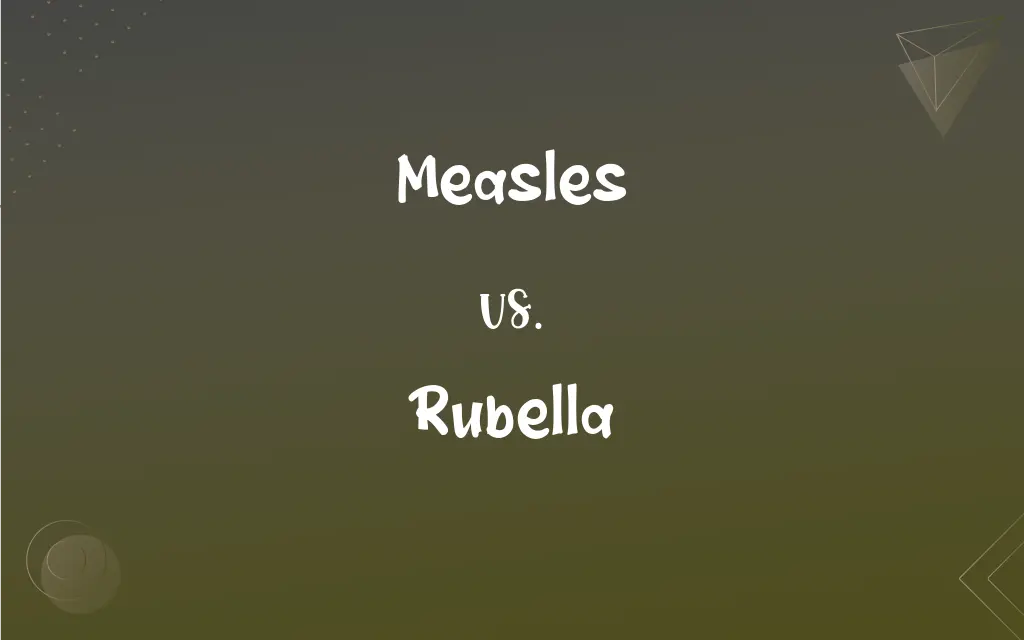Measles vs. Rubella: What's the Difference?
Edited by Aimie Carlson || By Harlon Moss || Updated on October 29, 2023
Measles is a viral infection causing fever, cough, and characteristic red rash; rubella, or German measles, is milder but can harm fetus in pregnancy.

Key Differences
Measles is a highly contagious viral infection characterized by a fever, cough, and red rash that starts on the face and spreads. It is caused by the measles virus. Rubella, also known as German measles, is a milder viral infection but can be serious if contracted during pregnancy, as it can lead to birth defects. It is caused by the rubella virus.
Measles typically affects children and can lead to serious complications such as pneumonia, encephalitis, and death. Vaccination has significantly reduced its incidence. Rubella is generally mild in children and adults, but if a pregnant woman contracts rubella, it can lead to congenital rubella syndrome in the baby, which can cause heart defects, deafness, and other complications.
The measles virus is transmitted through respiratory droplets, and the infection can spread easily in communities with low vaccination rates. Rubella is also transmitted through respiratory droplets, but it is less contagious than measles. Vaccination is effective in preventing both infections.
Both measles and rubella can be prevented with the MMR vaccine, which also protects against mumps. The vaccine is typically given in two doses, with the first dose administered at 12-15 months of age and the second dose at 4-6 years of age. The vaccine is highly effective and safe, and it is an important tool in preventing these serious infections.
Comparison Chart
Causative virus
Measles virus
Rubella virus
ADVERTISEMENT
Severity
More severe
Milder
Common symptoms
Fever, cough, red rash
Mild fever, pink rash
Complications
Pneumonia, encephalitis, death
Congenital rubella syndrome
Prevention
MMR vaccine
MMR vaccine
Measles and Rubella Definitions
Measles
Measles is a viral infection characterized by a red rash.
The measles rash started on Lucy's face before spreading to her body.
ADVERTISEMENT
Rubella
Rubella is a viral infection also known as German measles.
Jane had a mild case of rubella as a child.
Measles
The MMR vaccine protects against measles.
The MMR vaccine is highly effective in preventing measles.
Rubella
The MMR vaccine protects against rubella.
Vaccination is the best way to prevent rubella.
Measles
Measles was once common in the United States.
Measles cases have significantly declined in the United States thanks to widespread vaccination.
Rubella
Rubella is caused by the rubella virus.
The rubella virus can cause birth defects if contracted during pregnancy.
Measles
Measles can lead to serious complications.
Complications from measles can include pneumonia and encephalitis.
Rubella
Rubella is generally milder than measles.
Rubella symptoms are typically mild, but the infection can be serious during pregnancy.
Measles
Measles is caused by the measles virus.
The measles virus is highly contagious and can spread rapidly in unvaccinated populations.
Rubella
Rubella can lead to congenital rubella syndrome.
Congenital rubella syndrome can result in heart defects and deafness.
FAQs
What is rubella?
Rubella is a viral infection also known as German measles.
How is measles transmitted?
Measles is transmitted through respiratory droplets.
How does rubella affect pregnant women?
Rubella can lead to birth defects if contracted during pregnancy.
Is the MMR vaccine safe?
The MMR vaccine is safe and effective in preventing measles, mumps, and rubella.
What is measles?
Measles is a viral infection characterized by a red rash.
What are the complications of rubella?
The main complication of rubella is congenital rubella syndrome.
How is measles prevented?
Measles is prevented with the MMR vaccine.
Can measles be serious?
Yes, measles can be serious and can lead to death.
Can rubella be serious?
Rubella is generally mild but can be serious if contracted during pregnancy.
Is there a cure for measles?
There is no cure for measles, but it can be prevented with vaccination.
How does measles affect children?
Measles can be severe in children and can lead to serious complications.
What causes measles?
Measles is caused by the measles virus.
What causes rubella?
Rubella is caused by the rubella virus.
What are the complications of measles?
Complications of measles can include pneumonia and encephalitis.
What are the symptoms of measles?
Symptoms of measles include a red rash, fever, and cough.
Is there a cure for rubella?
There is no cure for rubella, but it can be prevented with vaccination.
How is rubella transmitted?
Rubella is transmitted through respiratory droplets.
How is rubella prevented?
Rubella is prevented with the MMR vaccine.
What is congenital rubella syndrome?
Congenital rubella syndrome is a condition that can occur in a baby if the mother contracts rubella during pregnancy.
What are the symptoms of rubella?
Symptoms of rubella include a pink rash and mild fever.
About Author
Written by
Harlon MossHarlon is a seasoned quality moderator and accomplished content writer for Difference Wiki. An alumnus of the prestigious University of California, he earned his degree in Computer Science. Leveraging his academic background, Harlon brings a meticulous and informed perspective to his work, ensuring content accuracy and excellence.
Edited by
Aimie CarlsonAimie Carlson, holding a master's degree in English literature, is a fervent English language enthusiast. She lends her writing talents to Difference Wiki, a prominent website that specializes in comparisons, offering readers insightful analyses that both captivate and inform.































































